John Groves
Operetta Research Center
22 February, 2017
The nomadic company of Staatstheater am Gärtnerplatz has staged a rare, highly successful and most enjoyable revival of Kalman’s 1917 operetta Die Faschingsfee (The Carnival Fairy), which, as it is set in Munich at Carnival time (February – before Lent), is most appropriate. Clearly, the good people of Munich think so too, as the run of performances has completely sold out, with more added. It is to be hoped that when the Gärtnerplatz Theatre eventually reopens, it will be possible to revive it there.
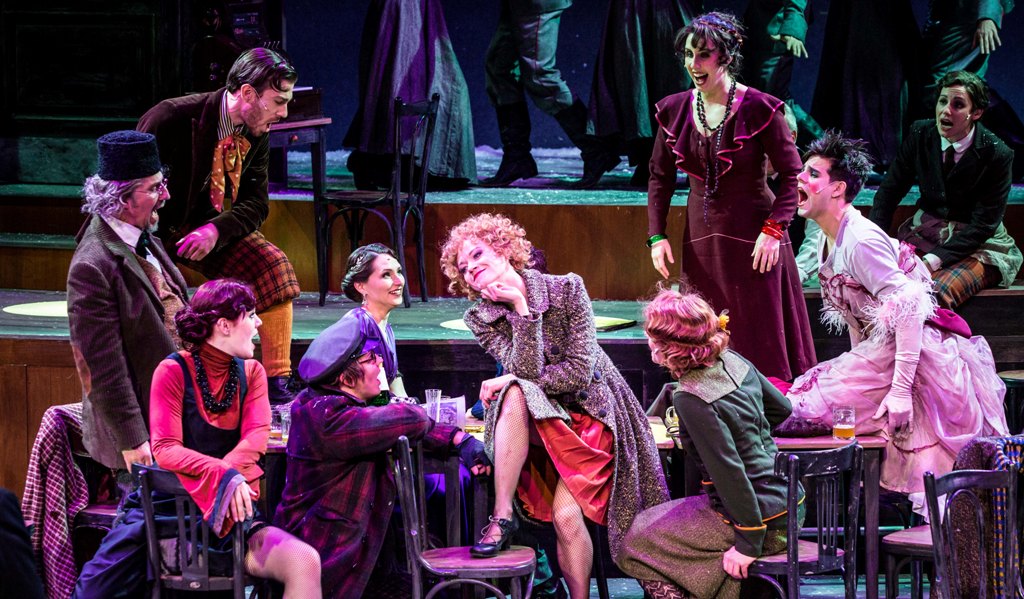
The ensemble in the new Munich production of “Die Faschingsfee” by the Gärtnerplatz Theater. (Photo: Marie-Laure Briane)
Whether it will be as successful must be in doubt, as the production is tailored to the flat-floored Alte Kongresshalle, which it seems to monopolize, with the audience on temporary staging on three sides of the acting area and the superb orchestra and conductor (Michael Brandstaetter) almost hidden from view behind the star-littered backdrop. This thrust stage arrangement not only means that every audience member is close to what is going on, but feels much more involved than in a traditional theatre.
The operetta is directed by the Gärtnerplatz’s Intendant, Josef Koepplinger, with tremendous energy and a great sense of the style needed for this piece, set in the last days of WW1 in an artists’ cafe peopled by a wide variety of interesting characters. There is no chorus as such, everyone being integrated into the action and given an individual character, whilst the ten members of the ballet, dressed in grey Red Cross uniforms, plus red balloons, are given the task of unifying the action and commenting on it in mime.
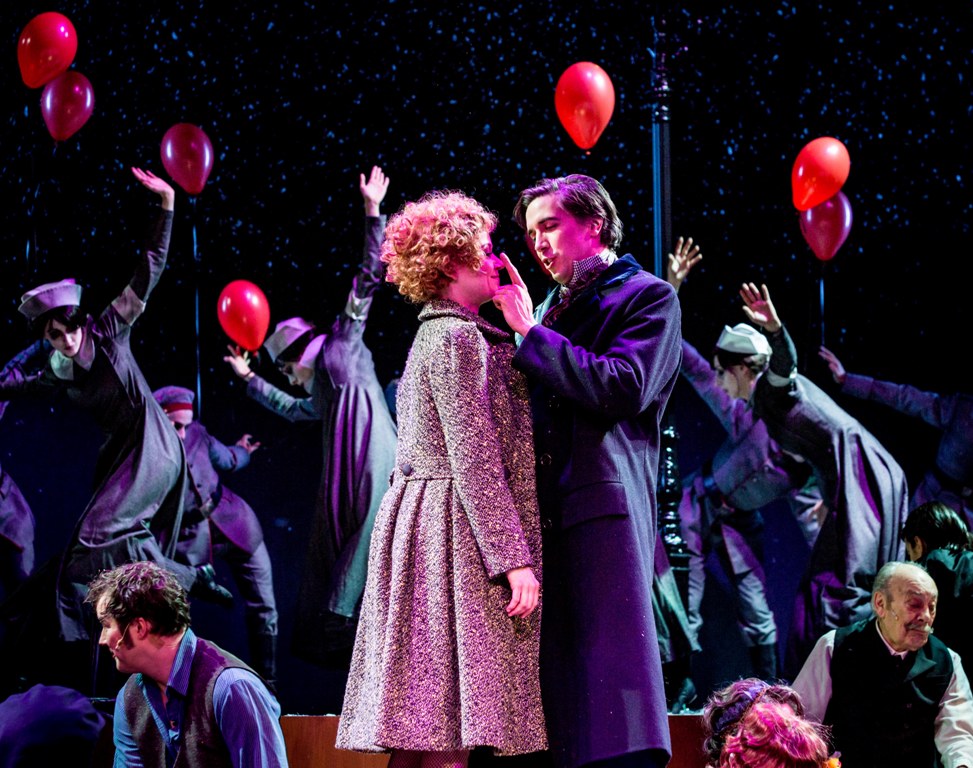
Nadine Zeintl (as Lori Aschenbrenner, Choristin), Simon Schnorr (as Baron Hubert von Mützelberg), and ensemble in “Faschungsfee.” (Photo: Marie-Laure Briane)
The plot concerns the widowed but still young countess Alexandra Maria, beautifully sung and acted by Camille Schnoor in a gorgeous costume (as are they all thanks to Dagmar Morell, the designer). Not only is she suave and beautiful, she is also the right age and her acting is totally convincing. She is charismatic and dominates the stage, even when just sitting listening. When Alexandra’s car breaks down outside the cafe, she meets the painter Viktor Ronai. Daniel Prohaska is totally convincing in this role, having the charm of a young artist who has just been awarded a 10,000 Mark contract for a fresco by Count Lothar Mereditt, (Maximilian Mayer) who is, unfortunately for Viktor, Alexandra’s ageing fiance! There are no prizes for guessing who Alexandra eventually marries!
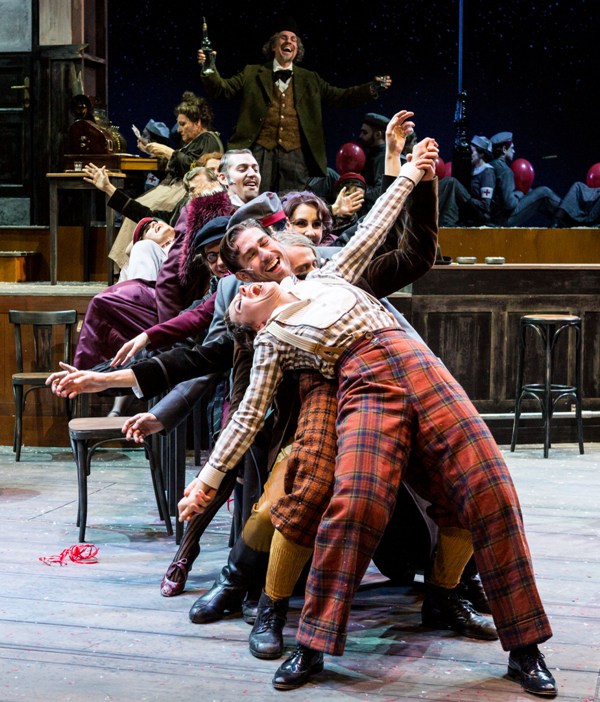
The dance ensemble in “Faschingsfee” in Munich. (Photo: Marie-Laure Briane)
The sub-plot concerns the romantic entanglement of chorus girl, Lori, both violent and jealous, acted with verve and great accuracy of punch by Nadin Zeintl, even if her singing is not quite as strong, and Baron Hubert (Simon Schnorr), who can do nothing right in her eyes! He has just the right amount of ‘devil-may care’ needed for this role, his eyes twinkling even when he is being attacked by Lori – as he is most of the time. Each throws themselves into their role with gusto.
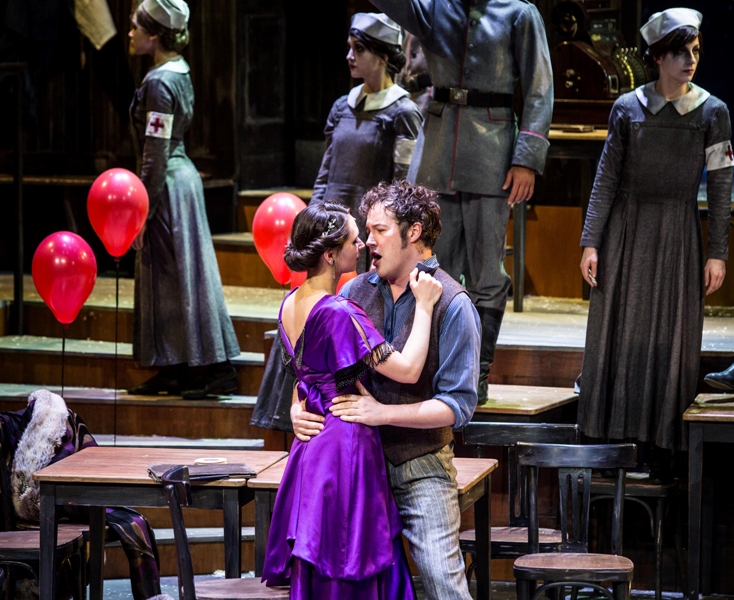
Camille Schnoor (as Fürstin Alexandra Maria) and Daniel Prohaska (as Viktor Ronai) in “Faschingsfee.” (Photo: Marie-Laure Briane)
In fact there is not a weak member of the team, including heart stopping ‘cameo’ moments from Josef Ellers, a lyricist in drag, Dagmar Hellberg as an old flame of Count Ottakar and k/s Gisela Ehrensperger, who has one of the most moving songs of the evening.

Gisela Ehrensperger in “Faschingsfee.” (Photo: Marie-Laure Briane)
As I have already intimated, the single set, designed by Karl Fehringer and Judith Leikauf, inhabits the Kongresshalle, taking full advantage of what might seem to less talented designers, obstacles.
Die Faschingsfee is one of Kalman’s early operettas, and as such has a plethora of wonderful waltzes, sumptuously orchestrated and done full justice to by the whole company. The show’s early history is too complex to be gone into here: it was seen in New York as Miss Springtime before being given in Vienna or Berlin. Not every number is a waltz: it just seems like that! (Listen to US dance band versions here.)
My only cavil is that the interval is taken half way through Act Two, which ruins the dramatic shape of the piece. In fact an interval is hardly necessary as end to end it is only 100 minutes in length!
Even if you cannot get tickets to see this wonderful, evocative, production (and if you can steal beg or borrow one do so!), the program is well worth acquiring and is a shining example of what all theatre programs should be: no advertisements (!), lots of color photographs of the production, and some very interesting articles: not just ones culled from other publications to fill space, but ones that are informative and relevant. Full marks!
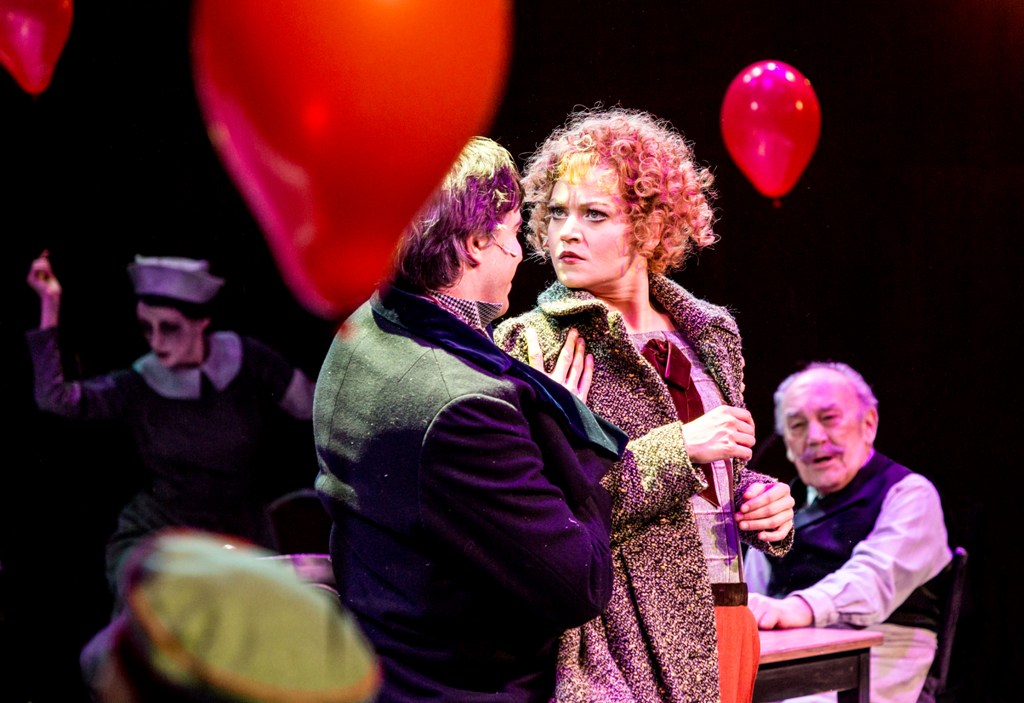
Simon Schnorr (as Baron Hubert von Mützelberg), Nadine Zeintl (as Lori Aschenbrenner, Choristin), Franz Wyzner (as Oberkellner Josef) in “Faschingsfee.” (Photo: Marie-Laure Briane)
There is at present, only one German language recording (Laserlight 14165) of this romantic, melodious, amusing show, from the 1980s in stereo, but it does show its age! However it can be recommended as it contains most of the score, and enthusiastic period style performances from Melanie Holliday (Alexandra) and Eberhard Büchner (Viktor) with the Cologne Radio Orchestra conducted by operetta specialist Peter Falk. There’s also an Ohio Light Opera version in English available on Albany Records, under the title The Carnival Fairy. And for a special treat: there are recordings of Fritzi Massary as Countess Alexandra, a role she performed with enormous success in Berlin at the Metropoltheater after her Csardasfürstin triumph. And: there is a recording of the sumptuous overture by Emmerich Kalman himself, from New York 1940. It’s part of the CD Kalman Conducts Kalman from Operetta Archives. It’s simply mavrellous!

THE ABOVE PERFORMANCE OF FASCHINGSFEE IS NOT THE KALMAN’S OPERETTA. IT’S AN AWFUL REMAKE THAT I JUST RECEIVED AS A CD AND I HAD THE NECESSITY TO WRITE A MESSAGE TO THE CPO DIRECTION THAT I REPEAT IT HERE:
Dear CPO Sirs,
I have just received from jpc and listened to your cd wrongly titled DIE FASCHINGSFEE and being a cpo-friend, for I bought ALL your miraculous discs, I was more than surprised that your label has accepted to put in their catalogue this offensive result to the ‘real’ and splendid Kalman operetta.
Please let me say my sadness because this infamous offer has everything – or almost everything – to be condemned. I had my piano score in my hands to follow the cd and found myself in a chaos trying to ‘reach’ where the offered music came from … I made myself nuts trying to figure that out … This is a pure fraud to people who loves the operetta theatre and it’s easy to understand why – it comes from the Gärtner-Platz-Theater where it’s a common thing not to recognize a work because they seem to use their intelligence to ‘change’ everything – to change what is not to be changed. . This cd is so far from all your products that you ought to cancel it from your catalogue or, at least, not to repeat such adventure in the future. I have to admit that I’ll be very careful to buy anything from cpo from now on. I am rightly aware that the beauty of a work is in its original form and not to the revised version unhappily created by assassins of the art.
I’ll never understand why you put this thing to your catalogue. I have now a certain ‘fear’ to listen to another cpo-cd I bought from jpc: EINE NACHT IN VENEDIG …. Oh JA JA JA, es ist die Korngold Fassung … is it really that or someone has thought to have the right to change it too? …
All your titles have always been a true joy to me, particularly with the Lehar operettas (even when I
had some reservation about something, never I felt sad because of your coherent respect for the ‘original’ score. To say all the truth I was only disappointed when I did not find the whole score with your WIENER FRAUEN … please do it again … ‘complete’) …
Your cd of DIE FASCHINGSFEE has also part of the dialogue … why haven’t you cut it? . There are – here and there – a few numbers which correspond to the score, but it’s all a hodge-podge which I am sure would have made my dear Emmerich Kálmán cry bitter and compassionate tears if he had to listen to it. What a pity and what a skulduggery from cpo. I would have never, NEVER, expected such a trick!
I have to confess that I’ll try with all my force to spread to everyone this opinion of mine because it is necessary …
Well, perhaps you will not pardon me and you will PERHAPS justify why this FASTENZEITSFEE has been thrown to the market …
I do hope you will NOT make the same mistake in the future because I DO hope you will make me happy again surprising me putting in the market Lehar’s PETER UND PAUL INS SCHLARAFFENLAND (believe it or not, and smile: : I interpreted the ‘Christkindlein’ Lied from it, in one of my operetta concerts!) and ROSENSTOCK UND EDELWEISS, DIE TANGOKOENIGIN … and why not! DIE GELBE JACKE …
… and why not one of the most beautiful Suppé’s operetta? I mean DONNA JUANITA …
… and why not Albini’s BARON TRENCK?
Well, my appetite may let me continue giving titles and titles and titles ..…
Before concluding my message I must let you know that DIE FASCHINGSFEE is much better represented in the commercial market with the american (yes!!) version from the Ohio light Opera Company (Albany records TROY1391-92 – it’s a pity they had a very unhappy cover for it) as well as the WDR release (LC Classic 14165 – Kölner rundfunkorchester/Dirigent Peter Falk).
All the best,
Ernesto Oppicelli
Via Certosa 1 a interno 3
16159 Genova Certosa
Italien
I have just added to my operetta collection the cpo-cd wrongly titled DIE FASCHINGSFEE and being a cpo-friend, for I bought ALL their miraculous discs, I was more than surprised that this label accepted to put in their catalogue this offensive result to the ‘real’ and splendid Kalman operetta.
I am indeed really sad about this infamous cd which has everything – or almost everything – to be condemned. With the piano score in my hands I was in a mere chaos trying to ‘reach’ the numbers coming from the cd … I made myself nuts trying to figure that out …I admit that a friend has also told me that there are two versions of this operetta made by Kalman himself – so: were also published two different piano score? I am sure 100% it is impossible to recognize here one or the other of the original scores … it’s only a pure fraud to people who loves the operetta theatre. Yes, a very few numbers correspond to the score, but it’s all a hodge-podge which I am sure would have made my dear Emmerich Kálmán cry bitter and compassionate tears if he had to listen to it. What a pity and what a skulduggery from cpo. I would have never, NEVER, expected such a trick!
I have to confess that I’ll try with all my force to spread to everyone this opinion of mine because it is necessary Hélas, nowadays it seems necessary to a lot of theatre managers to modernise, to change, to put a new look to their productions, the old has to become young! But those operettas are never old, their magic is in their natural pleasantness and the richness in the orchestral and vocal arrangements which are nearer to the classical music more than anyone may think. Is it bad then that after the show one can whistle a tune? Even going out from a performance of Puccini’s LA BOHÈME you may hear someone whistling the Musetta’s waltz. It is different with a Wagner opera! Oh ja ja ja.
I had to say my opinion and … since it happens when you are not in line with an audience that gives thunderous applause, I am expecting insulting answers! That’s how conditions are nowadays.